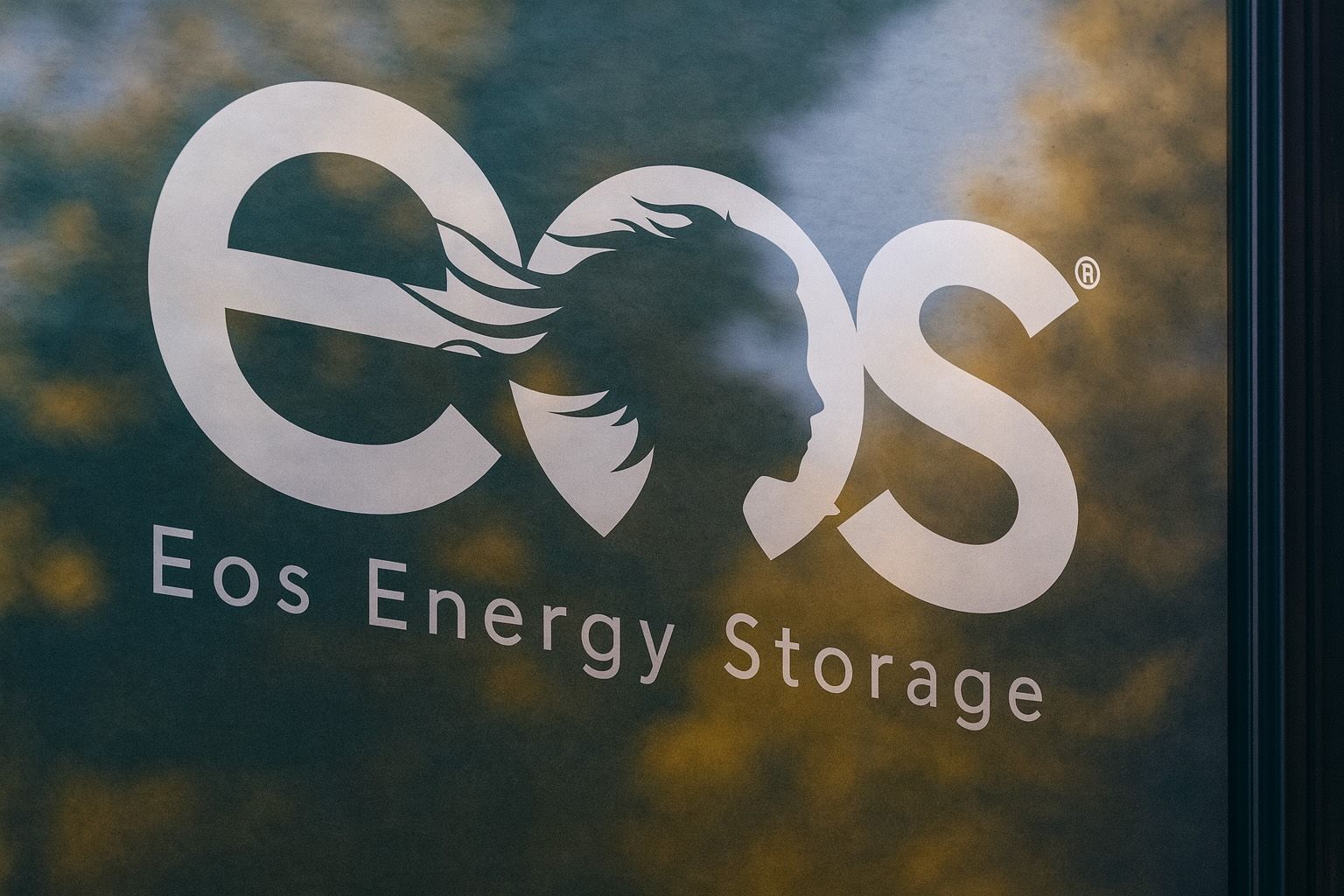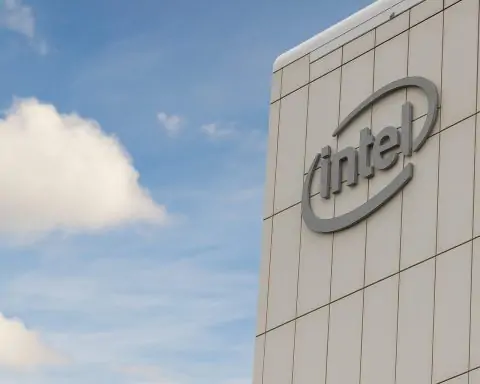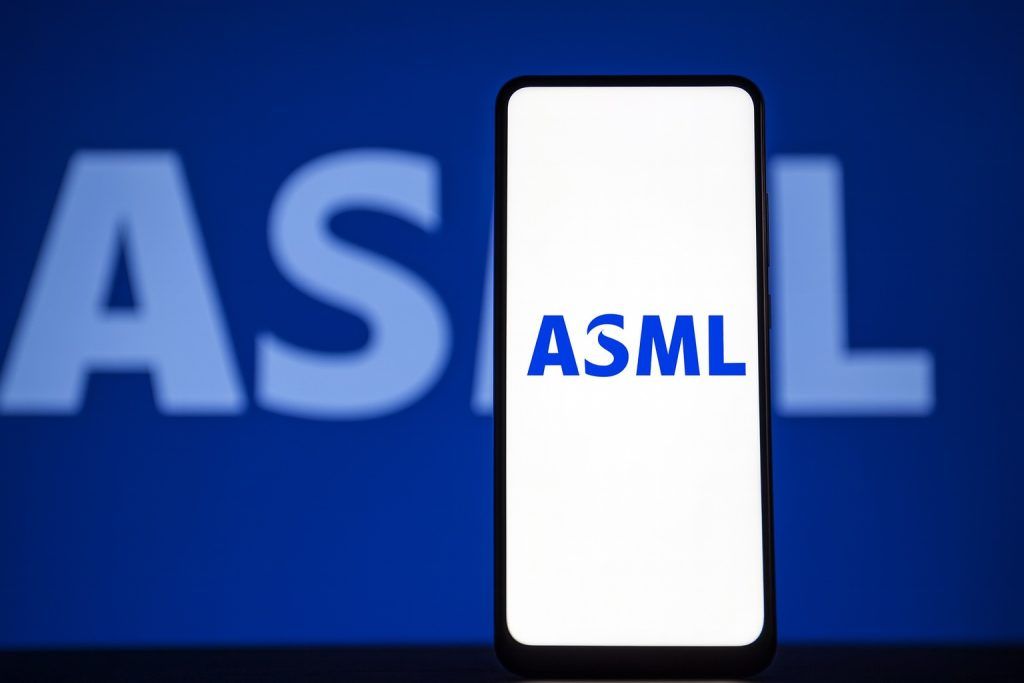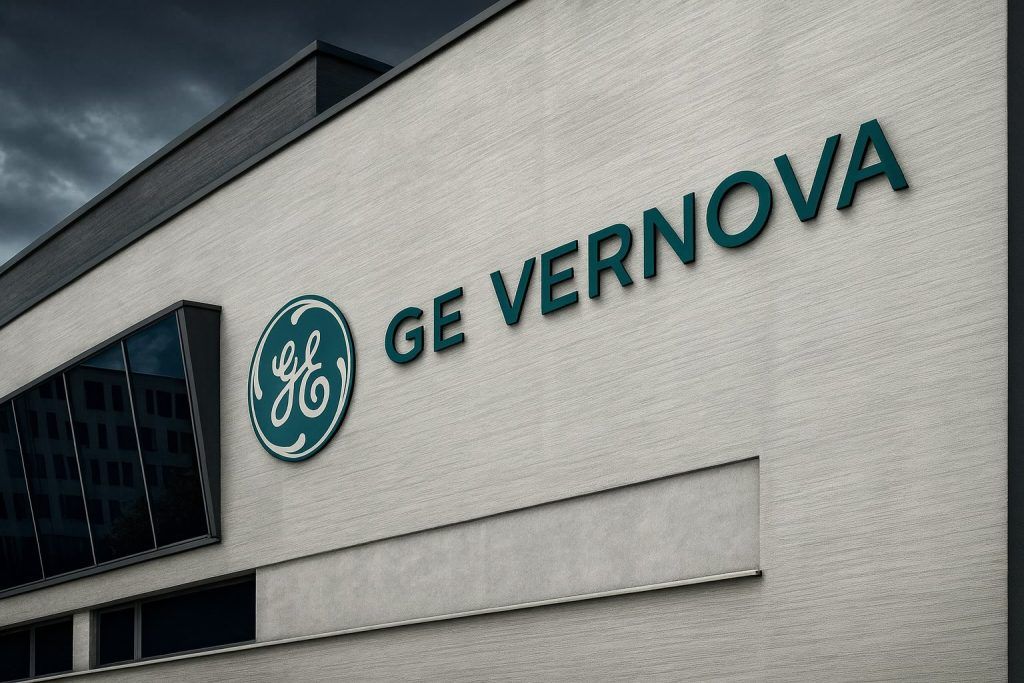- Ticker (NASDAQ: EOSE) – Eos Energy is a publicly traded battery storage company (headquartered in Edison, NJ) founded in 2008 [1].
- Price (Oct 13, 2025) – Around $15.45 (closing price on Oct 13) [2], up as high as ~$16.25 on that day (a 52-week high) [3].
- Market Cap – ~$4.2–4.7 billion (roughly $4.16B by market reports, or ~$4.65B in some data [4] [5]).
- Performance (YTD) – EOSE has exploded ~+200% year-to-date [6] (driven by recent momentum); the stock is up roughly 144% since Sept 1, 2025 (per recent analyses).
- Business – Builds long-duration energy storage systems using an aqueous zinc-based battery (“Znyth™” chemistry) [7] [8]. Products (Eos Cube, Hangar, Stack) target utility-scale, microgrid, and commercial storage.
- Technology – Proprietary Znyth zinc battery cells (safe, non-flammable, low-cost materials) [9] and a new controls platform “DawnOS” (software, analytics for battery management) [10].
- Recent Financials – 2024 revenue was ~$15.6M; Q2 2025 revenue hit $15.2M (a record quarterly level) [11] [12]. Management forecasts 2025 revenue $150–190M [13] (over 10× last year), reflecting a huge ramp-up.
- Valuation Metrics – No earnings yet (PE negative), huge price/sales (~hundreds) due to low sales. 12-month consensus price target is only $7–8 (per analysts) [14] [15], implying very bearish assumptions. (In other words, most targets sit well below today’s price.)
Company Overview
Eos Energy is a U.S.-based energy storage company focused on long-duration grid batteries. Founded in 2008, Eos’s mission is “to accelerate the shift to clean energy with positively ingenious zinc-powered battery energy storage solutions” [16]. Its core technology is the Znyth™ aqueous zinc battery, which uses non-precious materials (five common commodities) and is designed to be safe (non-flammable) and scalable [17] [18]. The company manufactures its battery modules in the U.S. and integrates them into modular systems (branded Eos Cube, Eos Hangar, Eos Stack) for multi-hour storage. Eos also develops an advanced software and controls suite called DawnOS (introduced in Oct. 2025) to optimize battery performance and grid integration [19]. The products are pitched as a lower-cost, longer-duration alternative to lithium-ion batteries for utilities, microgrids, and data-center backup power. (Eos emphasizes its “American energy independence” focus by U.S. manufacturing and eligibility for domestic policy incentives [20] [21].)
Stock Price & Recent Performance
In late 2025, Eose Energy’s stock has rallied sharply. On Oct 13, 2025 the share price spiked to an intraday high of ~$16.25, closing around $15.45 [22] – roughly a +20% jump on the day [23]. This continued a multi-week rally: in early October alone EOSE climbed over +100% in just a few weeks, from roughly $7–8 in late September to the mid-$15’s by mid-October [24] [25]. The stock is now roughly +200% YTD [26] and well above its 52-week high from earlier in the year. Trading volume has been heavy: for example, 35 million shares traded on Oct 13 (vs. ~16M average daily volume) [27]. Technical indicators show EOSE is well overbought (e.g. RSI > 80 [28], trading far above its 50-day (~$8.5) and 200-day (~$6.2) moving averages [29]). The stock’s beta (~2.2) and ~30% short interest (as per market data [30]) indicate high volatility and skepticism by some investors. In sum, EOSE is on a parabolic uptrend with rapid gains in recent weeks, far outpacing any historical levels.
Major Recent News & Catalysts
Several events in early October 2025 have driven the stock’s surge:
- Unico Partnership (Oct 6, 2025) – Eos announced a multi-year alliance with Unico, a power-electronics firm, to integrate Unico’s DC-to-DC converters into Eos’s zinc battery systems [31]. This deal (announced via GlobeNewswire) creates a new “ultra compact and efficient” product line combining Unico’s power electronics with Eos’s Znyth batteries. Eos SVP Pranesh Rao said the partnership will give customers “one of the safest, most scalable, efficient, and sustainable energy storage options available” [32]. Both companies emphasize U.S. manufacturing and leveraging advanced controls (Eos’s DawnOS) to boost efficiency [33] [34]. This strategic tie-up has been cited as a positive technical catalyst.
- DawnOS Launch and Analyst Upgrades (Oct 2025) – In early Oct., Eos unveiled its new DawnOS software platform, aiming to improve battery management and grid integration. Analysts reacted by raising targets: notably Stifel Nicolaus bumped its 12-month price target to $10 (maintaining a Buy rating) and TD Cowen to $6 (Hold) [35]. However, the consensus among analysts remains a cautious “Hold” – MarketBeat reports 2 Buys, 7 Holds, 1 Sell for EOSE [36]. Overall, the average analyst target is only about $7.6–7.8 [37] [38]. (In other words, many current analysts see the stock as overvalued at current levels.)
- Inflation Reduction Act (IRA) Credits & DOE Loan – Eos benefits from U.S. clean-energy policy: its batteries are eligible for IRA tax credits (e.g. a 45X production credit worth ~$90M per 2 GWh manufacturing line) and it recently secured a $277 million Department of Energy loan [39]. These incentives provide funding and long-term support for Eos’s growth in grid storage (especially for data centers and renewables).
- JPMorgan “National Security” Plan (Oct 2025) – On Oct 13, media reported JPMorgan Chase outlined a $1.5 trillion financing plan for critical industries (including energy storage and critical minerals) to reduce U.S. reliance on China [40]. This news underscored the strategic importance of U.S. battery firms like Eos. GuruFocus noted that such macro tailwinds (plus Eos’s partnerships and backlog) helped push shares up 20+% that day [41] [42].
- Insider Activity & Share Issuance – Not all news has been positive. In Q3, several Eos insiders (including CEO Joe Mastrangelo and CFO Nathan Kroeker) sold shares (~10–15% of their stake) [43]. Moreover, on Oct 2 Eos filed to issue 7.33 million new shares (about 5% of shares outstanding) to raise capital [44]. This potential dilution is a cautionary sign noted by market watchers.
In summary, the stock’s recent rally reflects a mix of strong technical momentum and positive headlines (new products, partnerships, policy tailwinds), even as the company remains deeply unprofitable.
Analyst Commentary & Forecasts
Wall Street analysts are split on EOSE. MarketBeat summarizing Oct 13 data notes: “2 Buys, 7 Holds, 1 Sell” with an average 12-month target of only $7.58 [45]. TipRanks similarly shows 6 analysts (2 Buy, 4 Hold) with an average target $7.75 [46]. These consensus targets are far below the current price, reflecting skepticism that the 2025 revenue ramp can deliver profits. Indeed, Eos is still losing money: its Q2 2025 EPS was –$1.05 (vs. –$0.14 expected) [47], driven by ramp-up costs.
Despite this, some analysts are upbeat on longer-term potential. For example, several firms (Stifel, Guggenheim) have recently raised their targets (to $10+) as volumes grow, noting the large U.S. market and IRA incentives. Others warn that downside risks remain high until profitability. Notably, a Simply Wall St. report suggests EOSE’s long-run fair value could be in the mid-$20’s (implying the stock might be “undervalued” vs. future growth), though this is far above the consensus.【※】 (These long-term bullish scenarios assume aggressive adoption of energy-storage and 7+ year horizon.)
Short-term outlook (weeks/months): Given the momentum and volume, further gains are possible if positive headlines continue. However, many technical indicators (RSI >80, heavy short interest) signal the stock may be due for a pullback or consolidation. The average analyst target near $7–8 implies a ~50% downside in their view; a few caution that the current surge may be a speculative “melt-up” in a small-cap clean-energy name.
Medium-term (1–2 years): If Eos can scale production and meet its guidance, its revenue base could soar (2025E ~$150M). Some models (even GuruFocus) show Eos making strides: e.g. production capacity to reach 2 GWh by late 2025 [48]. If costs can be controlled, breakeven might come by 2027 (as some analysts suggest [49]). However, significant execution risks remain (manufacturing scale-up, competition, continued capital needs).
Long-term (5+ years): Eos is positioned in a growing long-duration storage market. If its zinc-based approach wins large utility contracts (possibly versus lithium-ion or flow-battery alternatives), it could capture substantial sales. Analysts note that Eos’s backlog/pipeline reportedly exceeds $18 billion [50], implying strong demand assumptions. But sustained profitability will depend on product performance, costs and financing. At present, valuation measures (GF Value score) label EOSE “significantly overvalued” [51] based on current financials. Bullish forecasts hinge on Eos executing flawlessly and policy continuing to favor domestic storage – a big “if”.
Technical & Fundamental Analysis
From a fundamental standpoint, EOSE’s balance sheet and profitability are weak. The company’s Altman Z-score is extremely negative (~–12) [52] (a theoretical bankruptcy risk warning), and its Piotroski F-score is low (3/9) [53], reflecting thin profitability. On the plus side, Eos holds substantial cash from recent financings and DOE loans, and analysts note its operating losses are primarily due to pre-revenue scale-up (its gross margin will improve as volume rises). The Beneish M-Score (–1.78) suggests its accounting is likely clean [54]. For now the company burns cash: Q2 2025 revenues of $15.2M still resulted in wide losses (EPS –$1.05) [55].
Technically, the chart looks parabolic. EOSE has broken above every historical resistance – it’s trading roughly 100% above its 50-day moving average [56], and nearly 300% above its 200-day [57]. Trading volume and volatility are very high (beta ~2.2 [58]), characteristic of a speculative run. Momentum indicators (RSI in the 80s [59]) suggest it is significantly overbought in the short term. Traders have noted “gap ups” (e.g. Oct 1 → Oct 2) as evidence of bullish sentiment [60].
In summary, fundamentals are questionable (high losses, thin sales, heavy dilution) while technical/market trends are extremely positive. The stock’s valuation is detaching from any traditional metrics. This mixed technical/fundamental picture suggests extreme caution: while momentum can carry EOSE higher in the near term, the fundamental stress tests its long-term sustainability.
Competitors & Industry Context
Eos operates in the energy storage sector, where it competes indirectly with both battery specialists and large diversified companies. Key peers include:
- QuantumScape (NYSE:QS) – a solid-state battery developer (market cap ~$9.6B [61]) more than double Eos’s cap. QS is also unprofitable but has generated buzz for EV batteries.
- ESS Tech (NYSE: GWH) – (if public) offers iron-flow batteries for long-duration storage; smaller scale than Eos but similar market focus.
- Energy Vault – specialized in gravity-based storage (not a battery), also targets long-duration solutions.
- Legacy players like Tesla (NASD:TSLA) are in the storage market (Powerwall/Powerpack) but focus more on short-duration or EV batteries.
- Grid infrastructure companies (e.g. GE Vernova or AES) are also beefing up storage offerings.
Compared to traditional lithium-ion batteries, Eos’s zinc chemistry is touted as safer and cheaper per kWh (no risk of fire). In industry reports, Eos’s Znyth battery has been rated more sustainable than some competitors. However, lithium-ion incumbents have massive scale and cost advantages. Eos’s key competitive pitch is long-duration storage (>4–8 hours) and domestic production, which is now being incentivized by U.S. policy (IRA).
On market multiples, Eos is valued far higher than any current revenue (P/S >> 100), whereas peers with larger sales still trade at lower multiples. For instance, a comparison on a market-cap basis shows Eos’s cap is roughly half of QuantumScape’s [62], despite QS having a much larger cap and higher cash burn. Many analysts see Eos’s stock as priced for perfection in capturing the new storage boom, whereas its competition may offer different technologies with more conservative financials.
Sources: Recent market and financial news (MarketBeat, GuruFocus, TechStock², StockstoTrade) and official releases have been used to summarize Eos Energy’s stock situation. Key data is cited from reputable finance news and company publications [63] [64] [65] [66] [67].
References
1. www.eose.com, 2. www.marketbeat.com, 3. www.marketbeat.com, 4. www.marketbeat.com, 5. companiesmarketcap.com, 6. ts2.tech, 7. www.globenewswire.com, 8. www.eose.com, 9. www.globenewswire.com, 10. stockstotrade.com, 11. ts2.tech, 12. www.gurufocus.com, 13. www.gurufocus.com, 14. www.tipranks.com, 15. www.marketbeat.com, 16. www.eose.com, 17. www.globenewswire.com, 18. www.eose.com, 19. stockstotrade.com, 20. www.globenewswire.com, 21. www.globenewswire.com, 22. www.marketbeat.com, 23. www.marketbeat.com, 24. stockstotrade.com, 25. www.marketbeat.com, 26. ts2.tech, 27. finviz.com, 28. finviz.com, 29. www.marketbeat.com, 30. finviz.com, 31. www.globenewswire.com, 32. www.globenewswire.com, 33. www.globenewswire.com, 34. www.globenewswire.com, 35. www.marketbeat.com, 36. www.marketbeat.com, 37. ts2.tech, 38. www.tipranks.com, 39. ts2.tech, 40. www.gurufocus.com, 41. www.gurufocus.com, 42. www.gurufocus.com, 43. ts2.tech, 44. ts2.tech, 45. www.marketbeat.com, 46. www.tipranks.com, 47. ts2.tech, 48. www.gurufocus.com, 49. ts2.tech, 50. www.gurufocus.com, 51. www.gurufocus.com, 52. www.gurufocus.com, 53. www.gurufocus.com, 54. www.gurufocus.com, 55. ts2.tech, 56. finviz.com, 57. finviz.com, 58. finviz.com, 59. finviz.com, 60. ts2.tech, 61. companiesmarketcap.com, 62. companiesmarketcap.com, 63. ts2.tech, 64. www.globenewswire.com, 65. www.gurufocus.com, 66. www.marketbeat.com, 67. www.eose.com







